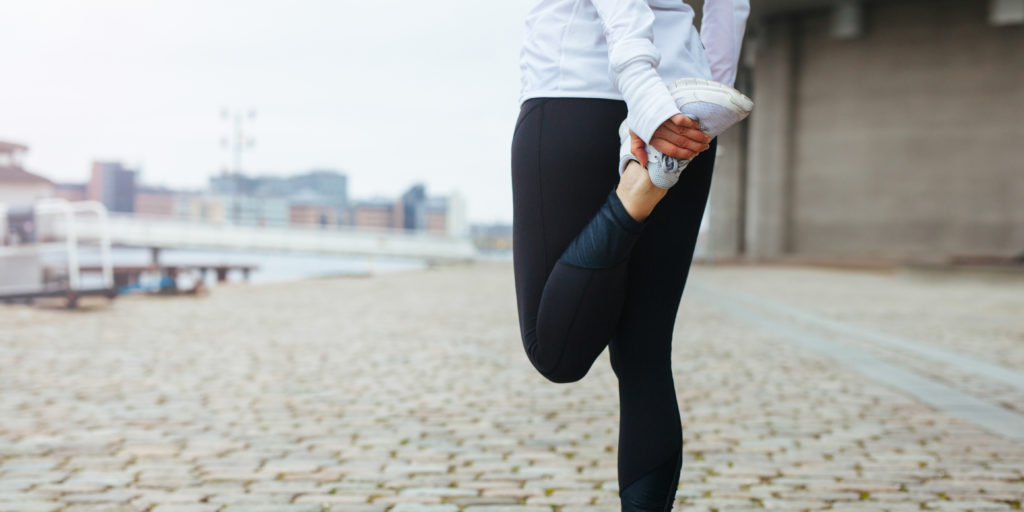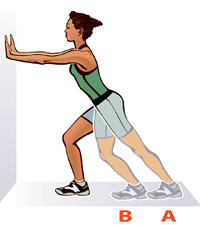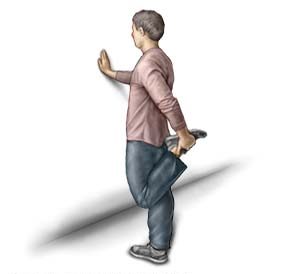4 Injury-Reducing Stretches for Runners
Running is a very physically demanding sport. Stretching is critical for any runner who wants to continue to enjoy it for a long time and avoid injuries.
Stretching helps you to maintain optimal joint function for athletic performance. It is best to stretch after a brief warm-up routine to avoid micro-tears in muscle fibers and fascia that could be caused by stretching a cold muscle and lead to pain and increased stiffness.
To prevent this, perform a quick five-to-ten-minute moderate intensity cardio exercise prior to stretching; a hot shower or sauna will also work.
There are two types of stretches: dynamic and static.

Dynamic Stretches
These stretches are best performed before to a run, and can help to increase muscle spindle length and prepare your muscles for activity. It can also help to improve blood flow and lubricate joints and muscles to help prevent injury.
Dynamic stretching involves moving joints through their greatest range of motion in a repetitive rhythmic pattern.

1. Forward and Back Leg Swings
10 reps per leg, 3 sets
This exercise is beneficial because it optimizes groin range of motion.
- Support yourself on a wall or a post, and hold your trunk erect with your abs contracted.
- Kick your outside leg forward from the hip as high as it will go, then swing it back as far as it will go.
- Increase the arc of the swing with each repetition
- Another variation on this exercise is to perform side to side swings.
Static Stretches
After a run, these stretches will help your muscles relax and restore them to their resting length. You should also perform static stretches as part of a regular daily routine; this can prevent tightness that may lead to injury.

2. Calf Stretch
Hold for 30 -60 seconds. 3 reps per leg, 3 sets
Gastrocnemius Stretch (A)
- Stand with one leg in front of the other.
- Point toes pointed, about two feet away from a wall.
- Place hands on the wall in front of you to brace yourself.
- Lean forward towards the wall with your chest, keeping your back straight and heel on the floor.
- Keep your furthest-back leg stretched straight.
Soleus Stretch (B)
- Same as the Gastrocnemius stretch, except this time the knee of the leg that is being stretched is bent.
- Keep your heel on the ground.

3. Standing Quadriceps Stretch
Hold for 30 -60 seconds. 3 reps per leg, 3 sets
This stretches the Quadriceps muscles, including the rectus femoris, vastus lateralis, vastus intermedius and vastus medialis.
- Using a chair, table or wall for balance stand up straight with feet together, spine erect and abs in.
- Keep hips in line and thighs together.
- Reach back and grab your left foot in your left hand concentrating on bringing your heel into your buttocks.

4. Hip Flexor Stretch
Hold for 30 -60 seconds. 3 reps per leg, 3 sets
This stretches the Rectus femoris and Illiopsoas.
- Kneel with one knee on the floor and the other foot in front with knee bent.
- Push your hips forward and keep the back upright.
Lyndsay Iezzi, B.Kin, C.Ped. (C)
Kintec Pedorthist
Questions? Ask a Pedorthist!
As always, don’t hesitate to come speak to a Pedorthist if you have any questions about preventing running injuries! Find a store near you now.

No Comments